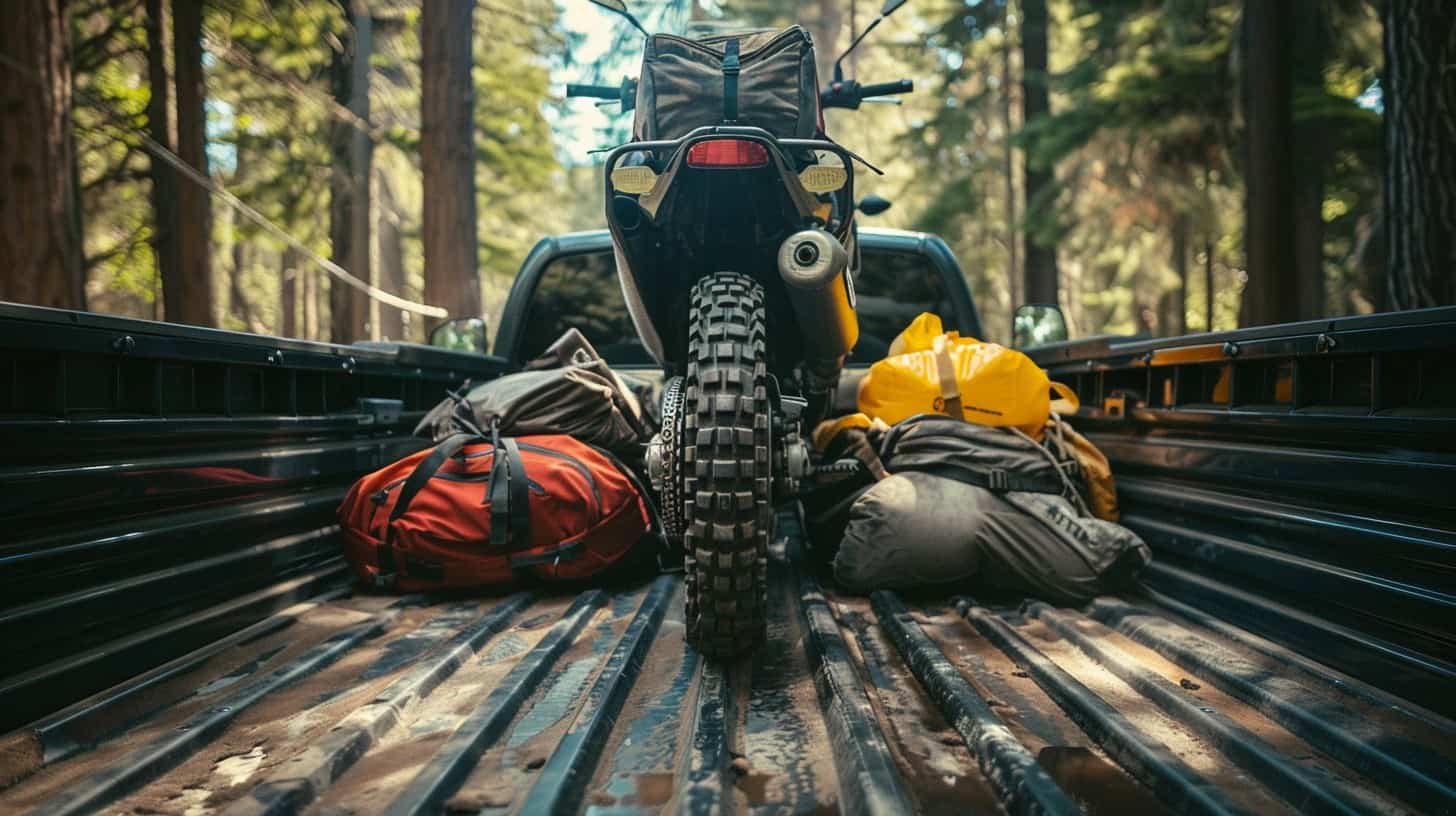Moving a motorcycle isn’t as easy as riding one. Many folks end up scratching their heads, wondering the best way to do it. This article will guide you through avoiding common blunders and pinching pennies while shipping your two-wheeler.
Keep reading; it’s worth it.
Key Takeaways
Before shipping your motorcycle, check it for any damage. Use a checklist and take pictures to protect yourself.
Secure your bike properly using ratchet straps and, if needed, a wheel chock or stand to keep it safe during transport.
Choose the right way to move your motorcycle based on distance, time, costs involved, and safety measures.
Lower the tire pressure and drain the fuel tank for a safer trip.
Make sure you have active insurance coverage for your motorcycle in case of accidents or damages during transport.
Table of Contents
Why Transport a Motorcycle?
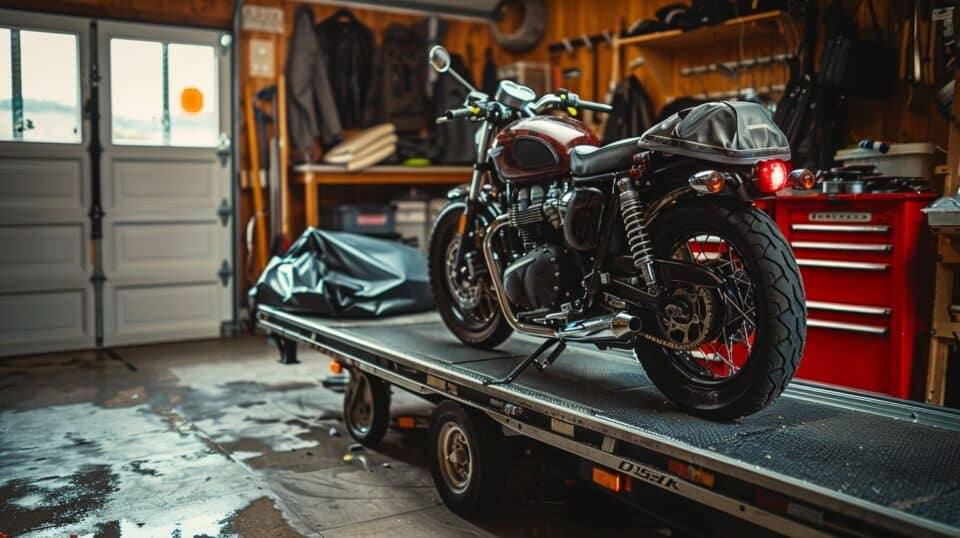
Shifting gears from the introduction, let’s dive into the heart of why moving your motorbike without riding it is a smart move. Shipping a motorcycle sparks convenience that’s hard to beat.
Imagine getting your bike across long distances without adding extra miles or wear and tear. It’s like giving your two-wheeled buddy a first-class ticket while you skip the hassle of long-hour rides.
Choosing A1 Auto Transport for this job brings peace of mind. These pros handle bikes with care, ensuring they reach their destination safe and sound. No need to worry about crates, insurance headaches, or shipping details – they’ve got it covered.
So whether you’re relocating or sending your ride ahead for an epic road trip adventure, motorcycle transport services offer the perfect solution to keep your bike in top shape and ready to roll upon arrival.
Factors to Consider Before Transporting Your Motorcycle
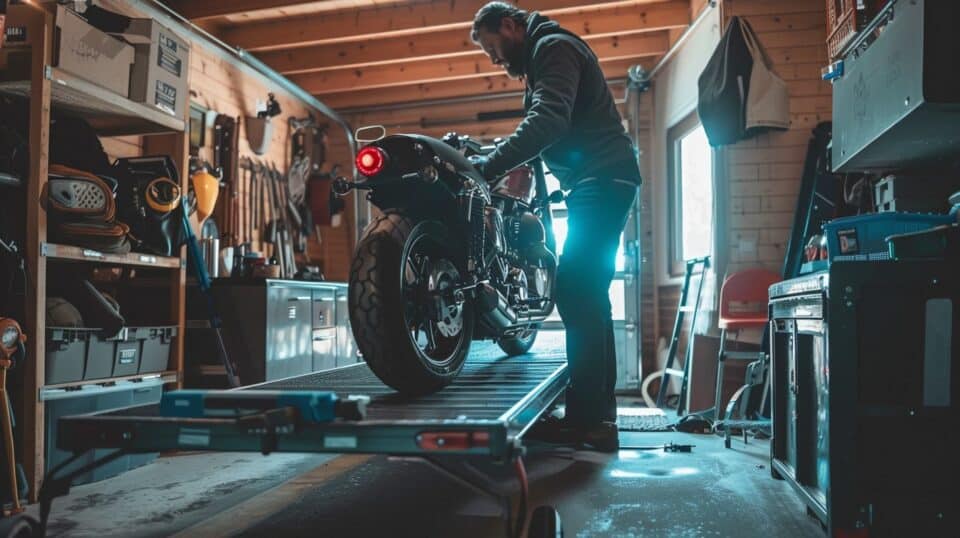
Before you ship your two-wheeler, think about a few things. How far does it need to go? It matters because longer trips might cost more and risk more bumps along the way. Also, consider how quick you need it there.
Time can affect price and options for shipping.
Consider the distance
The road ahead might seem long or short, but the miles matter. Picking the right way to move your bike depends on how far you’re going. If it’s a cross-town hop, maybe throwing it in the back of a truck does the trick.
But let’s say you’re aiming farther out, coast-to-coast perhaps. That’s where looking into freight companies or professional shippers pays off. They’ve got the tools for safe and speedy delivery over thousands of miles.
Distance plays a huge role in planning and costs too. A quick trip won’t hit your wallet hard, but gearing up for a long haul? That means more fuel consumption, higher prices, and getting all your ducks in a row with contracts and insurance from agents who know their stuff about shipments on flatbeds or trailers approved by FMCSA (Federal Motor Carrier Safety Administration).
So before hitting the road—or more accurately having someone else hit it for you—measure those miles well.
Time it takes
After figuring out how far the bike needs to go, it’s crucial to look at how long it will take. Getting your motorcycle ready for its journey isn’t a last-minute task. You’ll need about 3 to 7 days just for the crating process alone.
Proper advance planning beats rushing every time.
Sending your bike across the country? Freight shippers promise delivery in about 3 to 7 days, depending on where you’re headed. Opting for a national freight carrier means choosing speed and reliability for your two-wheeler’s trip.
Every hour counts, so picking a service that values timeliness as much as you do can save headaches down the road.
Costs involved
Time is money, and the journey from deciding to move your motorcycle to getting it where it needs to be can hit your wallet hard. Taking the DIY route? You’ll need cash for renting a truck or van, maybe even buying special straps or a stand.
It’s like planning a road trip but forgetting about gas money; these expenses add up fast. If you’re thinking of using a freight company, brace yourself. They might ask you to build a custom crate for your ride.
That means more dough out of pocket just to ensure your motorcycle doesn’t play bumper cars inside a shipping container.
Choosing how you transport your motorcycle isn’t just about picking between options; it’s about knowing what each choice costs upfront and hidden fees that sneak up on you like ninja expenses in the night.
Whether it’s rental charges from U-Haul, paying an independent hauler who knows his way around tow hitches better than most, or going all-in with professional shippers – every option has its price tag.
And don’t forget insurance! A chat with an insurance agent could save you big if an accident decides to crash your party uninvited.
Safety measures
Before hitting the road, double-check your motorcycle. It’s like giving it a good once-over before a big show. Check the brakes, make sure they grip tight and right. Lowering tire pressure can be a sneaky move for better stability during transit.
Don’t forget to drain the fuel tank to avoid any unwanted fireworks on your journey.
Your bike needs insurance coverage that stands tall against mishaps. Think of it as your safety net when you’re not around to catch it. Applying these steps can turn transportation from a nail-biter into smooth sailing.
Best Ways to Transport a Motorcycle
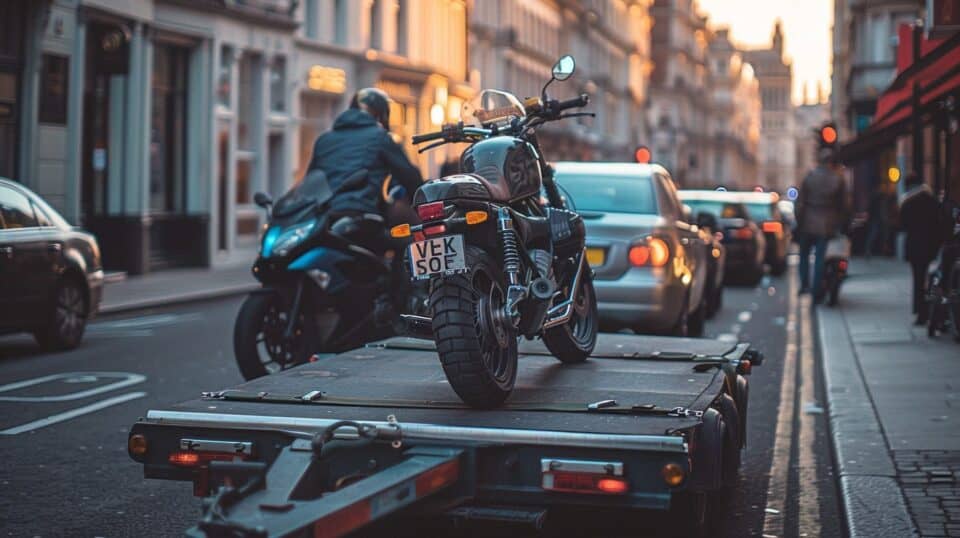
When moving your two-wheeler, you’ve got options. Think trucks or vans for a DIY move, freight services for long hauls, independent movers when you want that personal touch, or professional motorcycle transporters for all the bells and whistles.
Self-transportation with a Truck or Van
Hauling your motorcycle with a pickup or trailer hits the sweet spot between cost and convenience. You control the schedule, dodge pricey fees, and keep an eye on your bike every step of the way.
Make sure you have wheel chocks and ratchet straps. These tools are heroes for keeping your ride steady. Picture tying down a wild mustang — but it’s metal, has two wheels, and won’t neigh.
Before hitting the road, check if everything’s secured tight. A loose strap could turn your journey south in more ways than one. Next up: exploring freight companies as another way to move your motorbike safely across distances.
Using a Freight Company
Going with a freight company can be quick and generally reliable for moving your two-wheeler. Most of these carriers get your motorcycle from point A to B in about 3–7 days across most parts of the US.
They usually load motorcycles into fully-enclosed crates along with other goods, keeping them secure during transit. But here’s the kicker: these shippers lack specialized tools and know-how specific to motorcycles, which might make you sweat a bit about safety.
Since they treat your prized ride just like any other cargo, there’s a real risk it could end up getting cozy with items not exactly meant to share space with motorcycles. And let’s talk costs; if you decide to go this route, brace yourself for potentially higher prices due to custom crating and precise measurements required for shipping quotes.
Next up, let’s explore hiring an independent hauler as another option.
Hiring an Independent Hauler
Choosing an independent hauler can save you some cash. Still, watch out! These guys might not know the ins and outs of motorcycle care. They could lack the right paperwork or insurance, turning a cheap choice into a pricey mistake.
Think about it – if your bike gets damaged because they didn’t strap it down properly, you’re in for more than just a headache.
Before saying yes to an independent trucker, do your homework. Ask about their experience with motorbikes and check their license and liability insurance status. It’s like making sure the parachute is packed right before skydiving; you don’t want surprises mid-air! An informed choice means fewer worries for you and safer travels for your motorcycle.
Engaging a Professional Motorcycle Shipper
Hiring a pro to move your bike is like giving it a first-class ticket. They know motorcycles inside and out. These experts handle your ride with the care it deserves, using the right tools for a smooth journey.
They use specialized equipment that keeps your motorcycle safe—no bumps or bruises here. You wouldn’t pack your grandma’s china in a backpack, so why trust your bike to just anyone? Go with folks who speak ‘motorcycle’.
Choosing this route might cost a bit more than doing it yourself or going with general freight movers. But think about it—peace of mind comes with knowing your motorcycle gets VIP treatment.
It’s not crammed in a crate next to random stuff, but travels in style, avoiding scratches and dents. Plus, these shippers have insurance that covers any unlikely oops moments from pickup to drop-off.
In short, paying up front can save you headaches (and heartaches) later on.
How to Prepare Your Motorcycle for Transport
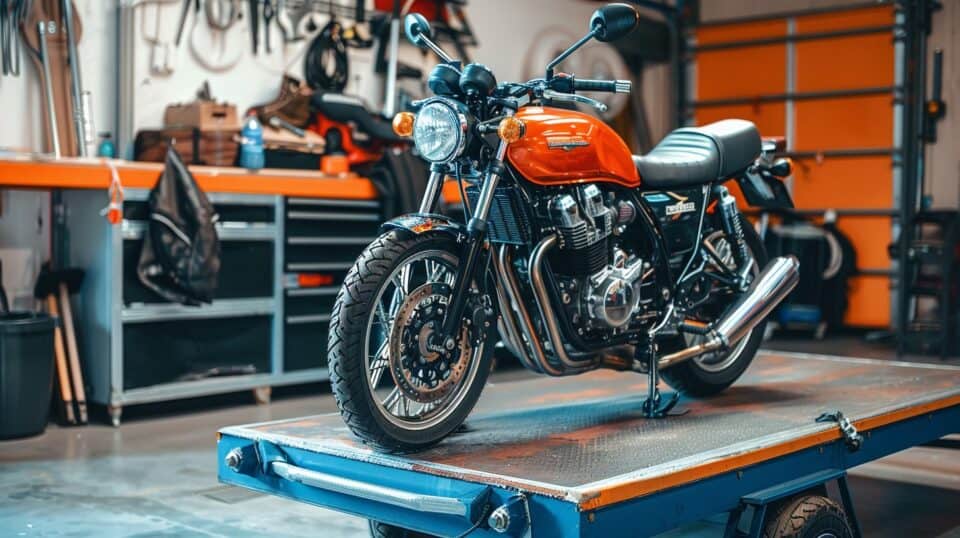
Getting your motorcycle ready for a move is like packing a suitcase – do it right, and everything fits perfectly. Check for any scratches or dents and take pictures so you know it’s in the same shape when it arrives.
Make sure your bike stands tall and proud, locked in place so it won’t dance around during the journey. If needed, throw in a wheel chock or stand to keep those wheels from rolling.
Ready to learn more about keeping your two-wheeled friend safe on its trip? Keep reading!
Inspect Your Motorcycle for Damage
Give your motorcycle a good once-over before you ship it. Check for any scratches, dents, or other damage. This way, you know exactly what shape your bike is in before it hits the road.
Use a checklist to make sure you don’t miss anything. Write down every detail and take pictures from different angles. These steps are like putting on armor; they protect both you and your ride.
Next up, grab some tools for closer inspection. A flashlight helps spot hidden cracks or leaks under the bike. If you find issues, jot them down on the bill of lading—a document that’s like a promise between you and the transporter about the condition of your motorcycle.
This paper is crucial if there’s a debate about damages later on. Think of it as keeping everyone honest.
Secure Your Bike in an Upright Position
After checking your motorcycle for any damage, it’s time to make sure it stands tall and proud during transport. Use ratchet or tie-down straps, not bungee cords, which can stretch and lead to a wobbly ride for your bike.
Ratchet straps are champs at keeping things tight without budging an inch. Think of them as the superhero belt that holds up the pants on your two-wheeled friend.
If you’re dealing with a truck or trailer, consider adding a wheel chock or stand. This extra step is like giving your motorcycle its own pair of sturdy boots, making sure it doesn’t tip over when hitting those off-road bumps.
Lowering tire pressure helps too, letting the tires soak up those road vibes instead of passing them on to your bike’s frame. Keep everything snug and secure to ensure a smooth journey from start to finish.
Install a Wheel Chock or Stand If Necessary
Putting a wheel chock or stand under your bike keeps it standing straight during the move. This step stops your motorcycle from falling over and getting damaged. Think of it as tying your shoes before running; you don’t want to trip halfway through.
You need something strong, like a wheel chock, to grip the ground and hold your bike tight.
Securing your motorcycle right saves you headaches later. Make sure the chock or stand fits well with the type of motorcycle you have, whether it’s a sportbike or any other kind. A good fit means less wobble and more peace of mind on the road.
So grab that wheel chock or stand, get it in place, and rest easy knowing your bike is safe for the journey ahead.
Transport Safety Checklist
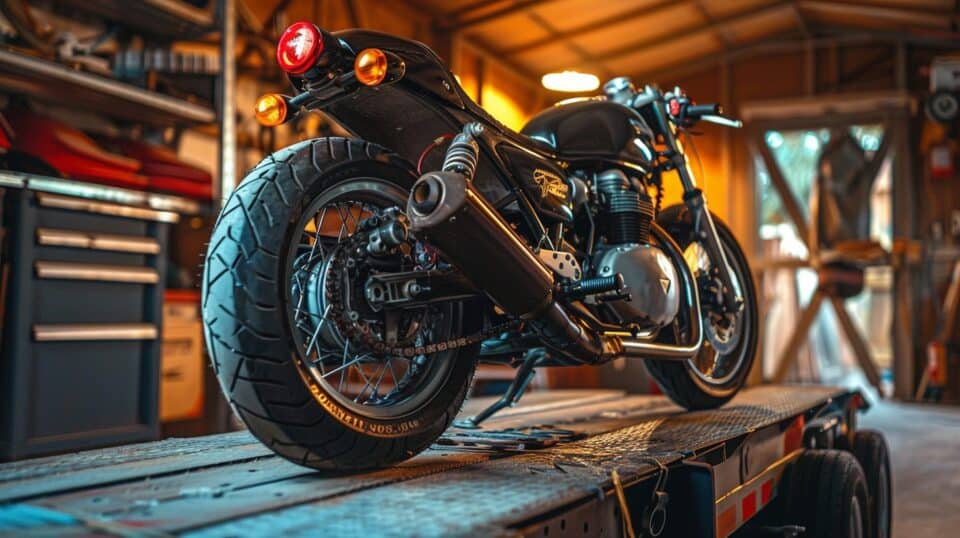
Before your motorcycle hits the road, make sure you’ve ticked off every item on the transport safety checklist. It’s like putting a helmet on your bike – necessary and smart!
Apply brakes
Make sure to apply brakes on your motorcycle before you start moving it. This simple step keeps your bike from rolling around during transport. Think of it as grabbing your coffee cup before taking a sharp turn in your car – it just makes sense.
Lowering the tire pressure helps too, but applying the brakes is key. It’s like hitting the pause button on a game controller; everything stays right where you want it until you’re ready to go again.
Lower tire pressure
After you apply the brakes, think about your tires. Lowering the tire pressure is like giving your bike a cushion for the journey. This simple step helps your motorcycle absorb shocks from bumps and potholes better.
Roads can be tough, but with softer tires, your motorcycle rides it out smoother. This keeps both the frame and components safer from harm’s way.
Lowering tire pressure isn’t just throwing caution to the wind; it’s smart planning. It minimizes damage risk during transport by making sure your motorcycle is less rigid and more adaptable to road conditions.
Think of it as tucking in your bike with a protective blanket that guards against potential damage while on the move.
Drain the fuel tank
Once you’ve lowered the tire pressure, the next big step is to empty the gas tank. Draining the fuel is a key safety action. It stops any chance of spills or leaks while your bike goes on its journey.
Imagine fuel leaking and creating a mess or worse, a hazard. That’s a scene you want to avoid at all costs.
To drain it right, follow clear steps. Use a siphon pump — an easy-to-find tool — to get all the gasoline out of your motorcycle’s tank. Make sure you do this in an open area with good airflow to keep things safe.
Store the drained gasoline in a proper container for later use or disposal, following local guidelines. This move isn’t just about safety; it also respects laws that limit transporting flammable liquids like gas during long hauls using trucks or freight services.
Active insurance coverage
Before you hit the road or hand your precious bike over to a trucking company, make sure it’s covered. Yes, we’re talking about having active insurance. This isn’t just a box to tick off for the sake of it.
Motorcycle insurance acts like an invisible shield around your bike. If something goes wrong during transport—a scratch here, a dent there—your policy steps in like a hero to cover the costs.
Now, rules aren’t the same everywhere you go. States have their own set of laws when it comes to motorcycle insurance. So, if your bike is crossing state lines, do yourself a favor and check those regulations ahead of time.
It’s better than getting caught off guard with unexpected fees or, worse, finding out your coverage isn’t valid in the destination state. Getting this sorted beforehand means you can sleep easy knowing your motorcycle is protected under its armor—all set for whatever journey lies ahead.
FAQs About How to Transport a Motorcycle
What’s the best way to move my motorcycle without breaking the bank?
Think of it like packing a suitcase for a vacation, where you can only bring your favorite outfits. You want to pick the right transport method that fits your budget snugly, just like those jeans you hope still fit. Look into towing options and compare pricing, but remember, sometimes flat-rate deals are your friend – they’re like all-you-can-eat buffets for moving!
I’m moving out for the first time and have no clue how to transport my sportbike safely. Any tips?
Moving out feels like stepping onto a rollercoaster blindfolded, doesn’t it? For your sportbike, think of it as buckling in tight before the ride starts. Use reliable towing gear or consider renting from trusted services like Uhaul to keep your bike as secure as if it were glued down. And hey, avoiding collisions is always a good idea – think of them as unwanted detours on your road trip.
Can I save money by doing everything myself when transporting my motorcycle?
Going DIY is like being a one-person band – possible, but tricky! If you’ve got the tools and know-how (maybe after binge-watching some WikiHow videos), you could cut costs by handling the payload yourself. Just be ready for recaptcha challenges along the way – proving you’re not a robot trying to escape with precious cargo.
Are there common mistakes I should dodge when moving my motorcycle?
Absolutely! Picture this: forgetting to check if everything’s tied up tight and watching in horror as things go south faster than birds in winter—that’s what skipping pre-move checks feels like! Ensure (oops, let’s say make certain) everything’s secured firmly; think twice before opting for suspiciously cheap deals that scream “collision ahead!” And remember, wisdom says learn from others’ oopsies rather than making them yourself.
